Through teams of researchers and students working collaboratively with community arts we accentuated the connection between the university and the local community, galvanised mutual learning and the value of slow research.
This seems to be the way of the world, whether you’re a practitioner, a researcher, or a community activist (or all three).
I was prompted to reflect on this when I (guiltily) turned down a request to collaborate on a project which involved working in an area I didn’t know, to produce desk research and broad community and stakeholder engagement including with “hard-to-reach” communities, and based on those two elements to deliver regeneration recommendations—all with minimally funded contact time.
The more I thought about this, the crazier it seemed and the less guilty I felt—an impossible task to do well, with huge responsibility invested in the output. How could I go into an unknown area, build relationships of trust with all of the businesses, communities, and hard-to-reach residents, understand the existing networks, relationships, assess the place, the physical and socio-economic realities, the scope of the proposed regeneration … and recommend how that regeneration should unfold over the course of a generation just by walking around for a few days, collecting some surveys and 30 minute interviews.
This made me reflect in a positive light on how my work has unfolded over several years in one of the most deprived parts of London, on its eastern edge: Thames Ward in the London Borough of Barking and Dagenham. Alongside colleagues and partners from a range of backgrounds, University of East London Sustainability Research Institute has developed incremental projects and relationships that together build a more substantive contribution to our local communities and places over time. Situated to the east of the city, adjacent to the Thames, it is an area that has experienced industrial decline over a long period but is now one of the most dramatically changing areas of the city. We have been working in Thames Ward for almost 20 years, with businesses, regeneration agencies, the local authority and residents and community groups on a range of research projects, large and small.
Thames Ward is home to 1950s council estates as well as low-tech industry, and it has a network of neglected green and blue spaces as well as a 2.5 km stretch of the river Thames. It is also the site of one of Europe’s largest regeneration projects, Barking Riverside, with 10,800 homes and infrastructure being built over a 30-year period, adjacent to the existing communities. The development has been designed with Sustainable Urban Drainage Systems at its heart, giving a distinctive appearance to the new neighbourhood in terms of an inter-connected network of retention ponds, swales, green roofs and rain gardens.
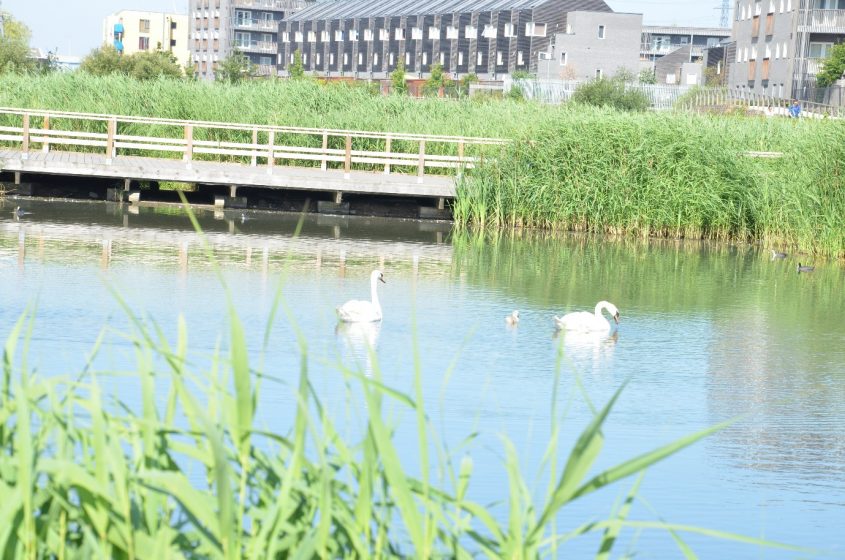
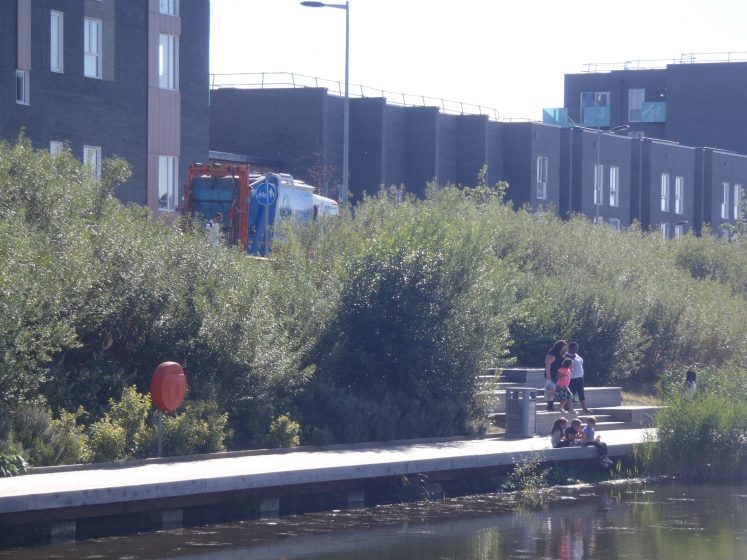
When I started working there in 2013, I soon found that—although the area looked lovely to my eyes—most residents had no idea why their green spaces were so unusually designed, for example so that grass areas were not flat and mown to enable children to kick a football. Or why there was so much water around, breeding mosquitoes. One residents’ association member said the ponds should be drained and concreted over. Others thought that the fact the place looks nice did not make up for the fact there were no shops or community facilities, and public transport links were so poor. This was all rather salutary feedback to someone passionate about sustainable urban design and nature in cities!
My learning experiences have grown exponentially over the years as I get to know more residents and communities across Thames Ward, in the old and new housing areas. This learning has been fundamental in shaping the form and scope of our interventions. I have become much more aware of the need to co-create research and intervention design, and to be flexible to follow rather than lead the direction of research and practice if I want to truly “engage with” and have meaningful impact for residents. Perhaps the most important lesson has been to listen and observe—and that we often learn much more when we do that rather than when we conduct surveys. (Aside: we’ve also learnt that residents get fed up of endless surveys!)
What have been the results of this “listening and following” research and practice? We’ve learnt that local residents do not know about their local environment, even that they are close to the River Thames, but they would like to know more. We’ve learnt that people in both the older and newer communities each think the other area has “all the good stuff”—and indeed at the start of our engagement that these two distinct communities did not consider themselves part of a coherent place, and—despite the regeneration “pitch” that existing neighbourhoods would benefit—there appeared to be little attention for the older estates. This led to us playing a more pro-active role in partnering with others to help shape the social development and local associations with nature.
For example, we mobilised student power to develop two projects with Thames View Infants school—increasing the landscape value and interest for part of the playing fields and designing and building an outdoor shelter for the pupils. You can read more about that project here.

As part of the NHS England Healthy New Town programme, we worked on a cycling project and a Blue Spaces project in Thames Ward. The latter involved developing a map of the whole of Thames Ward, showing the green and blue spaces, community assets and social infrastructure and walking routes and times, in partnership with Living Streets, a walking charity. We used the map as a process for engaging with residents and stakeholders: a series of led walks, taking the map to various community groups and community events, and we had drop in sessions to share the evolving map and get feedback for the final version over the course of several months.
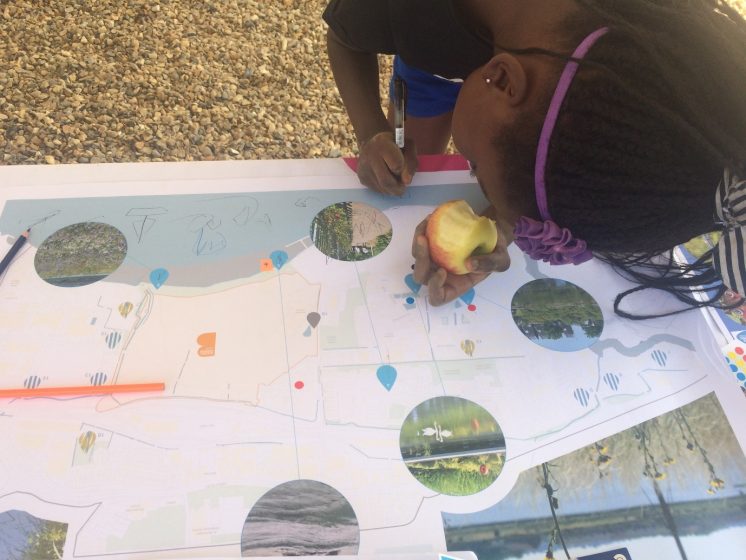
During this work, I met Susie Miller Oduniyi, a community arts practitioner and this led to further in-depth work in the area, we became involved in a new piece of work, the making of a local film by ‘New View Arts’. We were able to support this community-led project, which utilised a blend of local history, ecology and art. It enabled us to mobilise interdisciplinary teams and students to become actively involved in community development, recognising the value of building community relationships through a slow and consistent community engagement process.
I’ll pass the story over to Susie now, who will explain how we slotted in our expertise and student-power to their community arts projects.
Susie Miller Oduniyi—New View Arts
As an artist, I have been creating arts-led engagement projects on Thames View Estate for many years, building opportunities for local people to tell their stories. The initial idea to create an arts project that engaged local young people and children came from residents and members of the local tenants association, many of whom have been residents of the Thames View Estate for over 50 years. They were concerned about the lack of activities for local teenagers, residents Joyce Cracknell and Pam Dumbleton named the project New View Arts and actively supported and encouraged my Arts Council Application. I wanted to create a film that captured the unique local history of past Creekmouth Villagers while providing volunteering opportunities for young people who were not engaging with education or training, developing their skills while providing much needed arts provision for local children. New View Arts aims to inspire local residents to connect to their history through the arts, in a an area that has a constantly evolving demographic and where levels of arts engagement are low, only 25% of people in Barking and Dagenham spend time doing a creative, artistic, theatrical, or music activity or a craft according to The Active Lives Survey 2015-2017.
In March 2019 two artists carried out street-based engagement in Thames Ward to advertise the project to children and parents and engage young people who were not in education and training. We engaged 10 of these young people; four volunteered consistently throughout the project and six were involved in a lesser capacity, attending screenings and other community events throughout the project.
We ran six Saturday workshops from March to April with the four young volunteers (14-24 years old) and 28 local children (8-13 years old). The volunteers took on administrative and monitoring responsibilities, filming and photography, leading activities/games and facilitating exercises with the children. We invited members of The Creekmouth Preservation Society (CPS) to the sessions to be interviewed by the children and young people and share stories of living in Creekmouth Village, which was washed away in the great flood of 1953.
In April the four young volunteers took part in an intergenerational Ecology Course ran by the Sustainability Research Institute, University of East London (UEL). The course ran for 2.5 days and included classroom-based workshops, exploring the history of London’s water systems, walking in Thames Ward blue spaces and local wildlife and a day out to Walthamstow Wetlands. The volunteers supported the workshops and developed their camera and sound skills. Each of the young volunteers received a certificate from University of East London for completing the course.
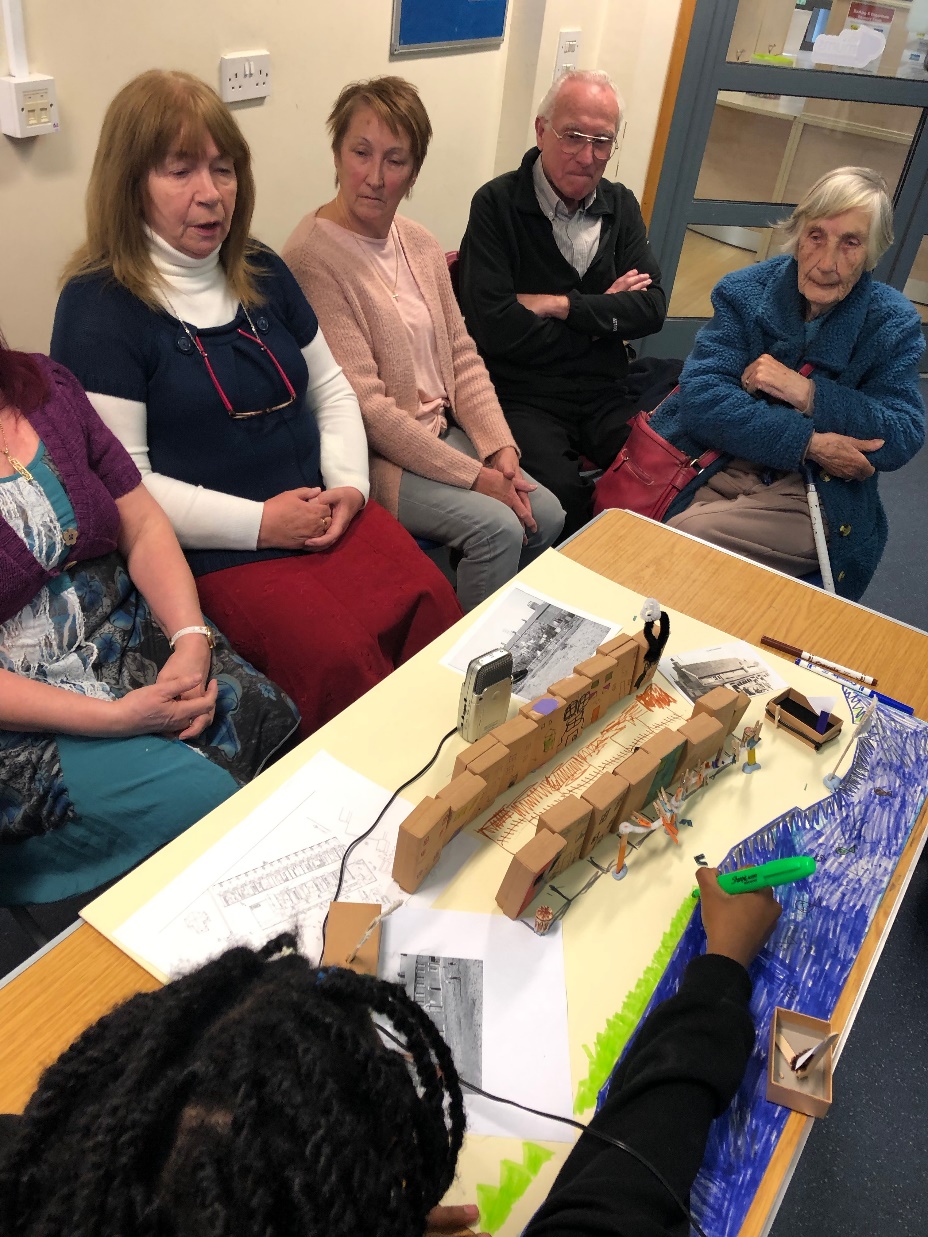
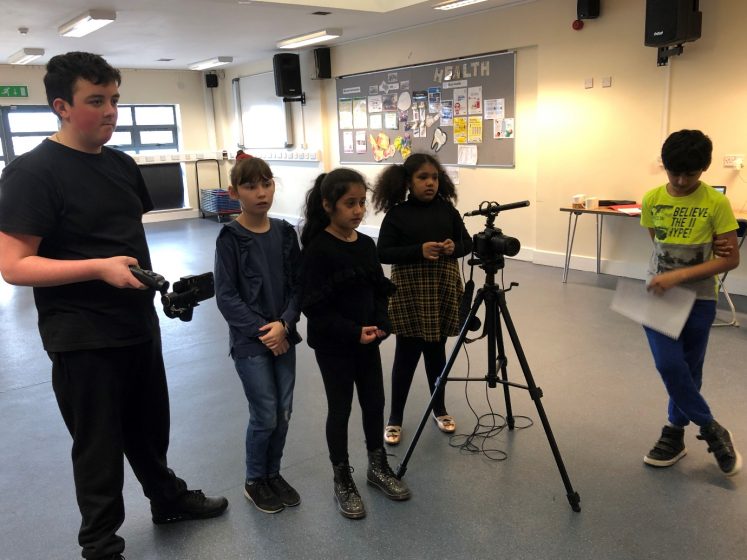
In August we held a summer programme of six workshops for 8 children, supported by the four volunteers, this included trips to Creekmouth Open Space to photograph, explore and film the area. We worked with Andrew Brown a photographer involved in documenting the local area as part of his MA in Photography, the children and young volunteers had the use of cameras to take their own photographs.
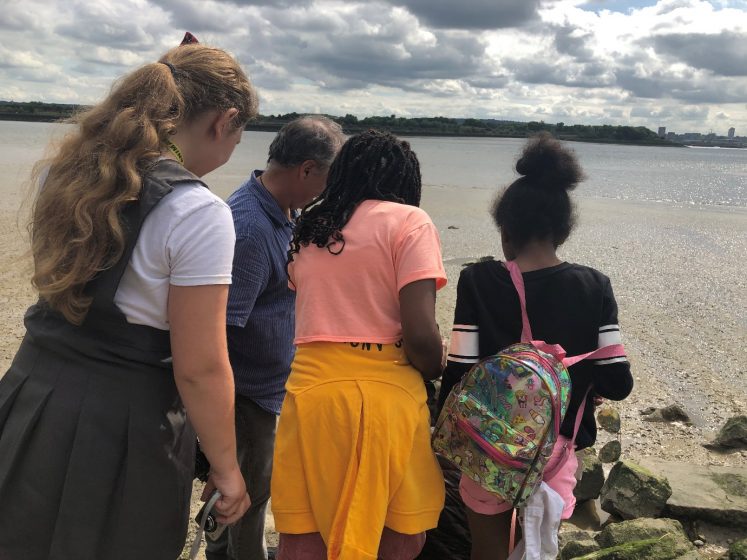
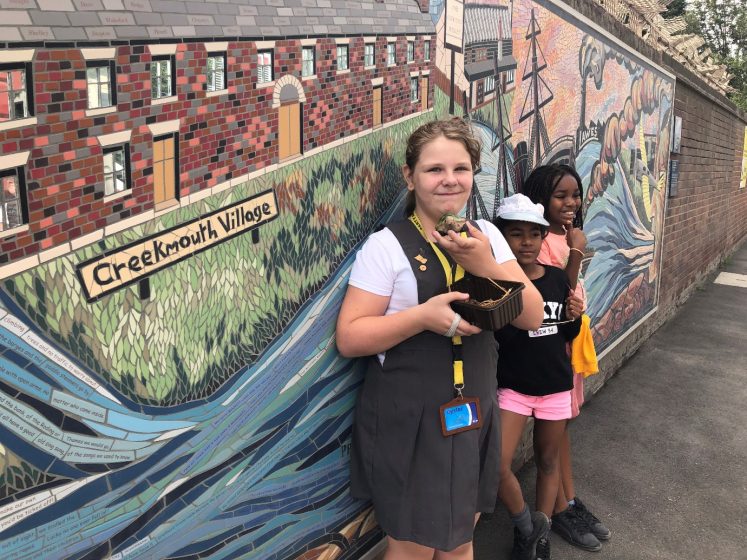
We held our first screening on the 31 October 2019 at the Sue Bramley Centre; we also held a screening for the CPS and their family and friends. Our final screening was held at The Sue Bramley Centre/ Thames View Library in December and was part of a wider Christmas celebration and included an exhibition by Andrew Brown of photographs of the project including ones taken by the children and young people. You can watch the 11-minute film on YouTube here:
Through our evaluation process with the young people, they cited that they felt that they had the opportunity to lead the project and gain experience and skills in an environment that they felt safe. Underpinning my engagement process is the principle of “Starting where people are at”, this ensures that the work highlights where the participants are starting from, in terms of their personal experience and skills and therefore produces a process that is engaging and relevant.
Building trust with the young people through consistent contact was important to keeping the young people engaged, finding opportunities and events that that artists and young people could attend together created contact time outside the workshops. This gave the young people the opportunity to meet local residents and other organisations, professionals working locally.
Through the creative workshop, the filming and making process allowed the children to immerse themselves into the narrative and really bring local history to life and build genuine intergenerational relationships with the members of Creekmouth Preservation Society. The film has also ensured that local older residents and past residents of Creekmouth Village have preserved their story on film, which we are continuing to share locally and wider afield.
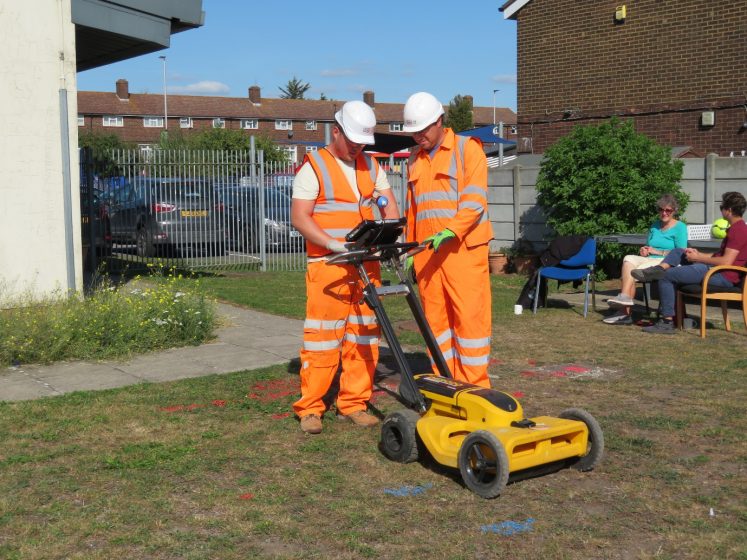
Shed Life
A linked project we have developed is called Shed Life. The project began in October 2018 initiated by local resident Pam Dumbleton and myself (Susie); we initially received £5k from Healthy New Towns (Barking Riverside) to deliver Phase 1 of the project (October2018-March 2019), which included the engagement of local men and the community within a regular weekly drop-in workshop to form a Steering Group. There is a real opportunity for local residents to be central to the development of our estate and small grass roots projects like ours really can make a difference to people who are at risk of being left behind.
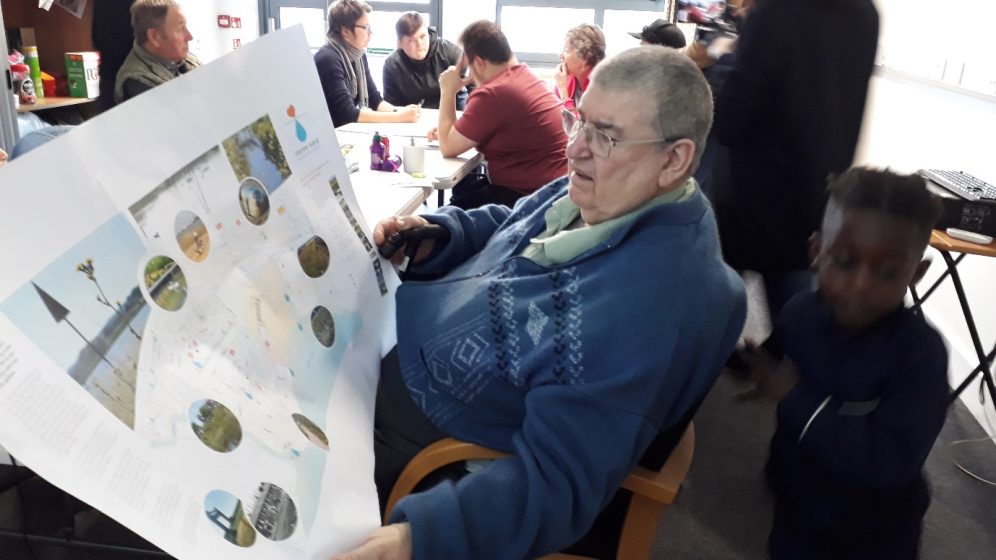
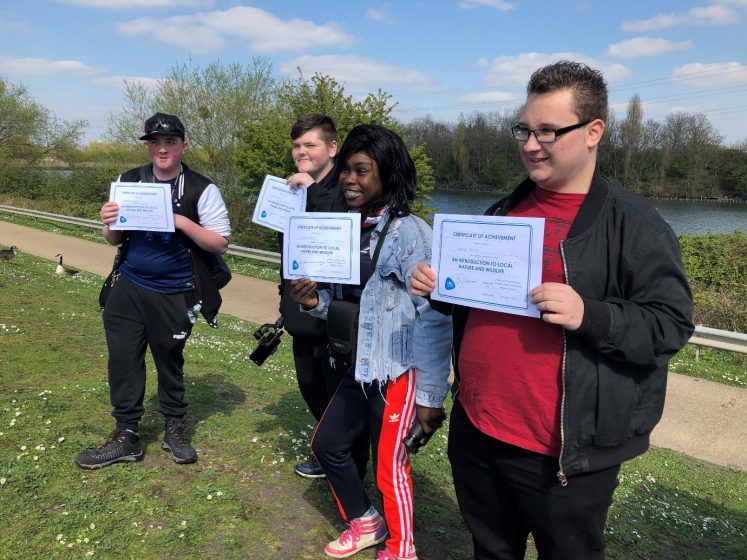
According to Public Health England Barking and Dagenham has the lowest life expectancy rate for men in the London Region, we want to provide local health related activities for men to make positive changes to their own health. A local space for men to find friendship, will support their physical and mental health and directly improve men’s lives and opportunities and contribute to our fantastic community here on the Thames View Estate.
We want to make a community space for men to connect, converse, and create. Providing activities chosen by the men to enjoy together. The purpose is to help reduce loneliness and isolation, to utilise the skills and talents that men can share with each other and create a project that is ultimately led by local men themselves. We have integrated the project with the four young people who volunteered on the New View Arts Project. The young volunteers are involved in developing the Shed with the men and are part of the steering group. We envisage that once the “shed” has been created the Shed Life Steering Group will manage the space with support from the TTRA and the Sue Bramley Centre, the local community hub.
We have a regular group of 10 local men (aged 37 – 75) and the four New View Arts volunteers and other local residents pop in as it is a regular point of contact each week to share information or just have a cup of tea. We have had a very positive response from local people and organisations to the idea of a “shed” and the men have enjoyed meeting new people especially the young people, who they have formed very strong bonds with. The group provides regular peer support for the men, young people and families. This has become an important local support network where the group feels safe to bring issues and get support. The majority of the men and young people have complex health and social issues including: mental health (depression and schizophrenia), learning needs, long-term sickness, mobility issues, bullying, domestic violence and isolation. The men have enjoyed being at the centre of the community and finding a space where they can share their problems and get safe advice and support. We have a robust Safeguarding policy and experienced project leaders and we link in with the staff at the Sue Bramley Centre who supports us with referrals to other agencies.
The group have discussed their ideas for the shed and were very keen that they wanted to create a space for the whole community to use, they have enjoyed being at the heart of the community and came up with a list of project aspirations and drew sketches of their ideas and named the project “Shed Life” The majority of the men have a number of health & mobility issues so the core activities they have identified at this stage are “soft”, including photography, model making, gardening and bird watching. This has all fed into the Stage 1 designs by the architect Sarah Bland, Studio Wic.
In March we held an event to celebrate the end of Phase 1 of the project, with a film screening of “A Northern Soul” with a Q&A with the Director Sean McAlister. The event included an exhibition of portraits of the group by photographer Andrew Brown and was well attended, allowing us to publicise the project further to local people and galvanise support. In April the men with the New View Arts young volunteers enjoyed taking part in the Blue Spaces course ran by the UEL Sustainability Research Institute exploring the local ecology and waterways. The course was funded by Healthy New Towns and allowed us to offer enriching activities to learn about our local environment and discuss our plans for “Shed Life” moving forward.
The group have been collaborating with the architecture department masters students at the University of East London (UEL) to design the shed guided by Alan Chandler Head of Architecture and we have gathered some amazing support from local companies who are providing pro bono support with surveying the land and laying the concrete foundations. Thanks to Sarah McCready, Barking Riverside London, we have made links with amazing companies working locally in Thames Ward. Thanks to Chris Dransfield and Johanna Ahlstrom at Barking Riverside Extension project (Morgan Sindall VolkerFitzpatrick Joint Venture)and Keith Brennan and Denis Cormican, PLS Civil Engineering, we have had a site survey, which has contributed to our planning application for the Shed. We were also lucky to have the Master Architecture students from University of East London help us with the planning application process as part of their course, supported and advised – again pro bono – by Ed Hanson at Barton Willmore.
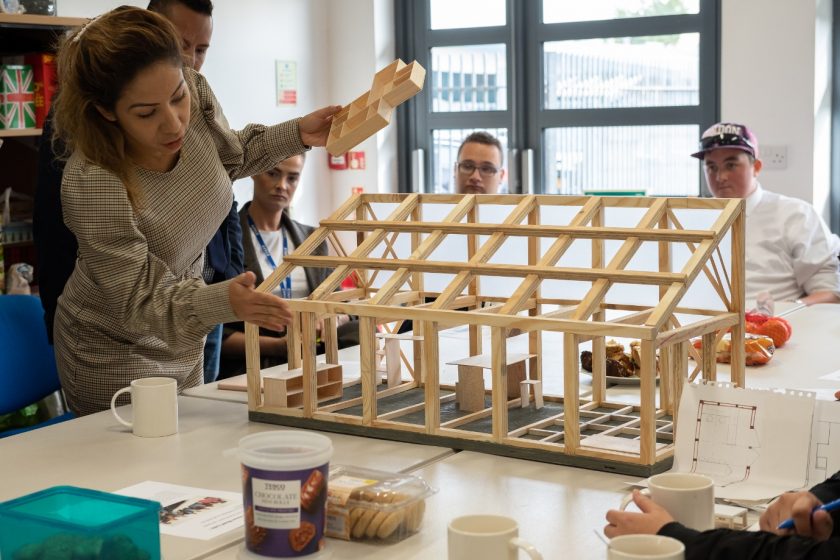
We have successfully raised some funds from the National Lottery for materials to build the shed, which the men will do with support from volunteers, and we generated extra funding for decking and ramps to make sure the shed is wheelchair accessible through a crowd-funding campaign. We are now planning for the shed to be constructed in Spring 2020. I am now fundraising to deliver training with the steering group to develop their leadership skills to manage the space for local people.
Back to Paula …
Through the Sustainability Research Institute team of researchers and students working collaboratively with New View Arts and Shed Life we accentuated the connection between the university and the local community, galvanised mutual learning and the value of slow research. We have built a mutual respect and opened many opportunities for further community development and most importantly demystified further education for local young people.
Paula Vandergert and Susie Miller Oduniyi
London
about the writer
Susie Miller Oduniyi
Susie Miller Oduniyi is the co-founder and Artistic Director of Humourisk, a Community Interest Company that create performance and art that redefines perceptions, co-creating work with communities and artists through creative exchange. Shed Life and New View Arts are current projects that have been co-created with the communities of Thames View Estate in Barking.


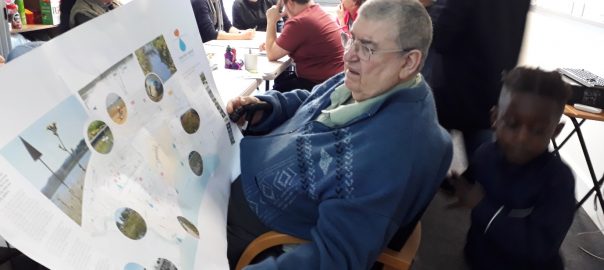
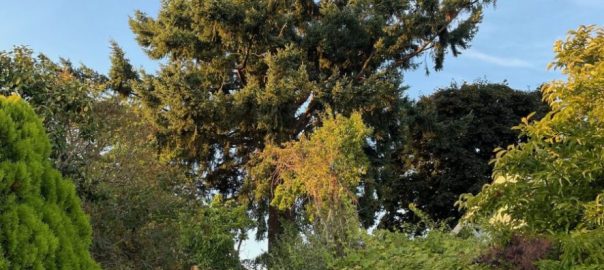
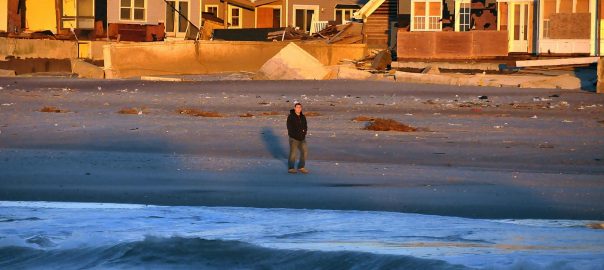
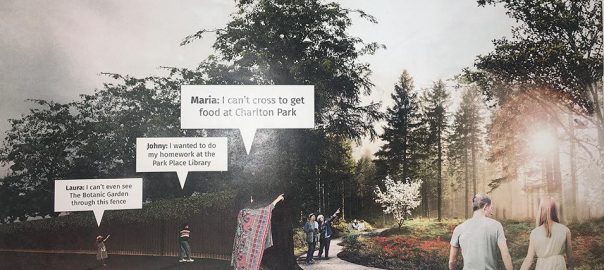

Leave a Reply